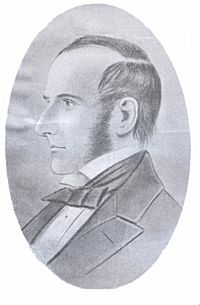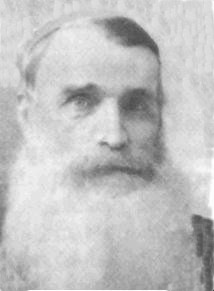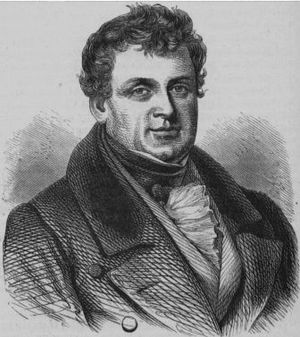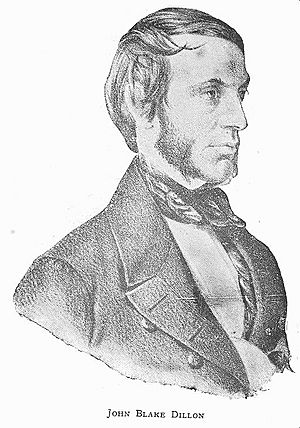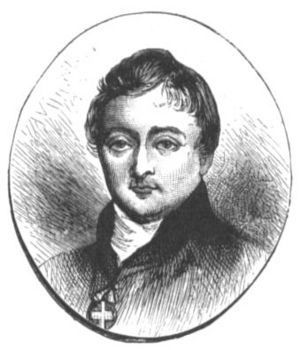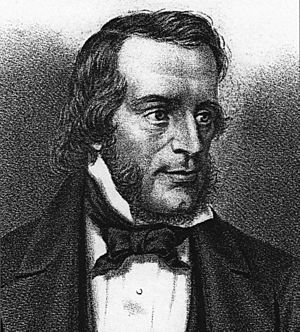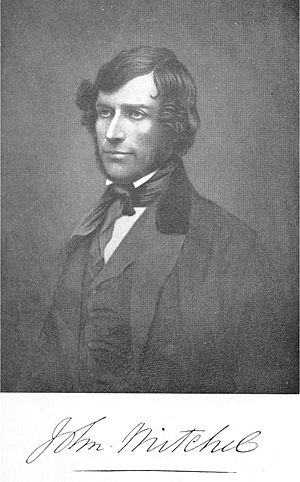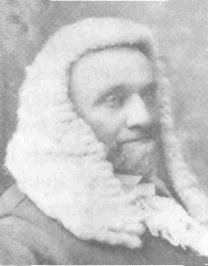James Fintan Lalor facts for kids
James Fintan Lalor (whose name in Irish was Séamas Fionntán Ó Leathlobhair) was an important Irish revolutionary and journalist. He was known as one of the best writers of his time. Born on March 10, 1809, he played a big part in the Irish Confederation, a group also known as Young Ireland. He was involved in the 1848 Rebellion and another attempt at a rising later that year. Lalor's ideas and writings greatly influenced future Irish leaders like Michael Davitt, James Connolly, Pádraig Pearse, and Arthur Griffith.
Contents
- James Fintan Lalor's Early Life
- Studying at Carlow College
- Life After College
- The Tithe Campaign
- Lalor's Political Views
- Temperance and Community Work
- Disagreements with the Repeal Association
- Life in Dublin and Belfast
- Writing for The Nation
- Writing for The Irish Felon
- Arrest and the Rising
- Lalor's Lasting Impact
- Lalor's Family
- Images for kids
James Fintan Lalor's Early Life
James Fintan Lalor was born in Tinnakill House, Raheen, County Laois (then called Queen's County) on March 10, 1807. He was the first son of Patrick "Patt" Lalor and Anne Dillon. His parents had twelve children. His father, Patrick, became the first Catholic Member of Parliament (M.P.) for Laois in 1832. Patrick also led a movement against paying tithes, which were taxes to the Church of England.
When James was a baby, an accident left him with a disability. Even though he was small and often unwell, he showed surprising strength. He was never sent to a regular school but was taught at home until he was seventeen.
Studying at Carlow College
In February 1825, James went to St. Patrick's, Carlow College. There, he studied chemistry and classics. He joined the Apollo Society, where students explored literature and music. A major influence on James at college was Bishop James Doyle. Bishop Doyle was very important in discussions about tithes, education, and freedom of religion. The college encouraged a strong sense of Irish patriotism. This spirit later showed in James Fintan's life and in other students like John O'Leary.
During his time at college, James worked hard and learned a lot about chemistry and law. His understanding of law became clear in his later writings. He often suffered from poor health and had to return home in February 1826 because he was very ill.
Life After College
Not much is known for certain about James's life right after college. Some stories say he worked for a doctor in Portlaoise. Other accounts suggest he left because of a personal disappointment. It's also been said he planned to go to France, but there's no clear proof he ever did.
For several years, there isn't much definite information about what James Fintan Lalor was doing.
The Tithe Campaign
In 1829, Catholics gained more rights, but Patrick Lalor believed they wouldn't be truly free while they had to pay tithes to a "foreign faith" (the Church of England). Patrick, supported by his family, publicly declared he would stop paying these tithes.
When officials tried to collect the tithes, they seized twenty of the Lalor brothers' sheep. However, the family used a legal process called replevin to get their sheep back. When they tried to sell the sheep, they painted "Tithe" on them, so no one would buy them. The sheep were eventually sent to England, but even there, no one wanted them, and most died on the journey. This campaign showed how politically active the Lalor family had become.
Lalor's Political Views
Politics became very important to the Lalor family. In 1832, Patrick Lalor was asked to speak before a special committee because he was a leader in Daniel O'Connell's Repeal Association. Patrick founded the Laois Liberal Club, which helped with elections. He won a seat in Parliament, which was a big victory. However, in 1835, he lost his seat.
At this time, secret groups like the Blackfeet and Whitefeet were active in Ireland. These groups often reacted to landlords evicting tenants. James Fintan Lalor believed the real problem was the landlords' power to remove tenants. He felt that land ownership was the key issue, and this idea shaped the rest of his life.
Temperance and Community Work
In 1838, Father Mathew started a campaign against alcohol. Millions of people gave up drinking. Fintan Lalor joined a temperance society in Raheen. In 1840, he suggested the society should do more than just promote temperance. It became The Shamrock Friendly Society, aiming to offer free legal help to the poor and organize reading and healthy games.
Lalor was also influenced by William Conner, a farmer who suggested ideas for fair rents and secure land for tenant farmers. Lalor strongly supported Conner and attended his public meetings. Conner was later jailed for a speech and expelled from the Repeal Association because he suggested people shouldn't pay rent until Ireland gained independence. Fintan Lalor agreed with Conner, and this marked the beginning of his political disagreements with his father.
Disagreements with the Repeal Association
In 1840, Daniel O'Connell restarted the Repeal Association, which aimed to repeal the Act of Union between Ireland and Great Britain. James Fintan Lalor strongly disagreed with O'Connell and the Association. He thought O'Connell's approach was wrong. He even wrote a letter to Robert Peel, the head of the government, asking for the Association to be stopped.
This difference of opinion caused a serious rift between Fintan Lalor and his father, who admired O'Connell. Their relationship completely broke down after an article Fintan Lalor wrote in 1844. As a result, Fintan Lalor had to leave home.
Life in Dublin and Belfast
After leaving home, Fintan Lalor went to Dublin. His health worsened, and he became very ill with a chest problem, likely tuberculosis. His father sent him money to help. Although he could have returned home, he tried to find work instead. He went to Belfast to learn about a special bank that offered fair loans to the poor.
He fell ill again, even vomiting blood, and was urged by family and friends to return home. He wrote to his father, apologizing, and they made up. However, Fintan Lalor stayed in the city, still trying to find work. But his health failed again, and he was finally forced to return home to Tenakill by March 1846.
Writing for The Nation
The Great Irish Famine pushed Lalor into direct action. He tried to start groups to protect tenants' rights and organize rent strikes.
Starting in January 1847, Fintan Lalor began writing powerful and sometimes controversial letters and articles for newspapers like The Felon and The Nation. Writing from his family home, he shared his strong views on current events, especially land reform. His writing style quickly got attention. He famously wrote that compared to the land question, repealing the Act of Union was "a petty, parish question." He stated he would never support simple repeal.
Lalor believed the Irish Confederation should aim for "national independence." He argued that they should not limit their methods or promise to use only peaceful means. He wrote, "if any resolution, or pledge, be adopted to seek Legislative independence by moral force and legal proceedings alone... you may have millions better and stronger men than I to join you; but you won’t have me."
In another letter, he wrote about the famine, describing the widespread suffering and death. He criticized landlords for collecting rent while people starved. He believed landlords were forcing people to defend themselves. In September 1847, Lalor tried to organize a meeting in County Tipperary to promote his land reform ideas, but it didn't achieve the results he hoped for. He wasn't a strong public speaker, and his poor health made public campaigns difficult.
Writing for The Irish Felon
John Mitchel, a leader of the Irish Confederation, was very impressed by Lalor's ideas on land reform. Mitchel later adopted Lalor's policy of pressuring landlords by refusing to pay rent.
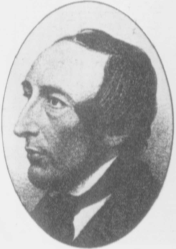
After failing to rally farmers, Lalor returned home. He reappeared publicly in June 1848, working with John Martin on a new newspaper called The Irish Felon. This paper started after John Mitchel's newspaper, United Irishman, was stopped and Mitchel was sent away.
Lalor wrote powerful articles for The Irish Felon, with titles like "What must be Done" and "The Faith of a Felon." His articles were so strong that three of them were used as evidence against John Martin in a trial for treason. Lalor took responsibility for the articles and asked for the charges against Martin to be dropped, but this was refused, and Martin was also sent away.
Lalor wrote: "The rights of property may be pleaded. No one has more respect for the than I have; but I do class among them the robber’s right by which the lands of this country are now held in fee for the British Crown." He believed that the current land ownership was unfair and based on conquest.
In another article, "The First Step—The Felon Club," Lalor directly challenged the government. He stated, "We hold the present existing government of this island and all existing rights of property in our soil, to be mere usurpation and tyranny." He announced plans to create a military organization, with the Felon office as its center. In his last article for the paper, "Clearing Decks," he asked, "Who strikes the first blow for Ireland? Who draws first blood for Ireland? Who wins a wreath that will be green forever?"
Arrest and the Rising
Six days after his last article, Lalor was arrested. He was held in prison for several months, and his health suffered greatly. He was released because of his poor health.
Despite his weakened state, Lalor's spirit remained strong. The next year, he tried to organize another uprising in Tipperary and Waterford with others like John Savage and Joseph Brennan. In September, Savage and Brenan attacked a police barracks, but other leaders didn't have enough forces, and the rebels had to scatter.
Just three months later, on December 27, 1849, James Fintan Lalor died at 42 years old from bronchitis. He was buried in Glasnevin Cemetery.
Lalor's Lasting Impact
The James Fintan Lalor Commemorative Committee was formed in 2005 to create a memorial for him. They raised €110,000, and a bronze statue of Lalor holding a pamphlet was sculpted. The inscription on the statue reads: "Ireland her own, and all therein, from the sod to the sky. The soil of Ireland for the people of Ireland."
Michael Davitt believed Lalor was "the only real Irish revolutionary mind in the '48 period." Lalor's ideas were very important for the Irish National League during the Land War, a movement to help tenant farmers.
Lalor's Family
James Fintan's brother, Richard Lalor (born 1823), was also a Young Irelander. He later supported Charles Stewart Parnell and served as an M.P. for Queen's County from 1880 to 1892. He died in 1893.
His youngest brother, Peter Lalor (1827–1889), moved to Australia in 1852. In 1854, Peter led gold miners in an armed uprising known as the Eureka Stockade. He later became a Member of the Victorian Legislative Assembly and even served as Speaker.
Images for kids


